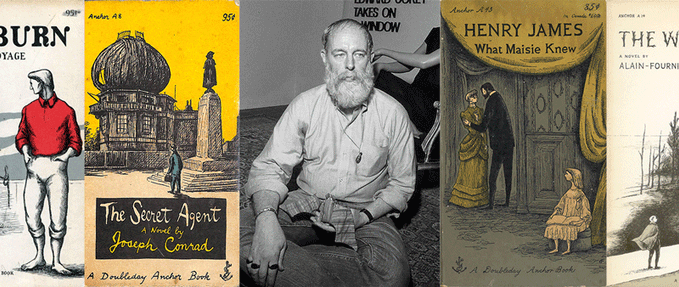Edward Gorey is best known for original works like The Gashlycrumb Tinies and The Unstrung Harp. But before he became the face of macabre, Victorian-style illustration, he lent his artistic talents to acclaimed classics by Joseph Conrad and Henry James.
After serving in World War II and studying the arts at Harvard, Gorey accepted his first post-grad gig at a New York publisher in 1952. There, he worked as an editor in their art department, spearheading the cover design for their latest titles—from choosing the appropriate typography to drawing the illustrations himself. More than that, though, Gorey was a key player in one of Doubleday’s major initiatives: to introduce an upscale paperback that would appeal to intellectuals.
Years before, the imprint Pocket Books had brought paperbacks to the mainstream, sparking a movement that influenced big name publishers to follow suit. By the 1940s, mass market editions—cheaply-produced, 25-cent softcovers—had flourished, but were largely associated with "lesser," pulp fiction. Their covers of buxom, barely-clad damsels had given the format a "bad" reputation, and were scorned by literary types.
Enter Doubleday Anchor and Edward Gorey, whose combined efforts (in addition to collaborations with other famous artists) resulted in the "trade paperback." These books were curated from the publisher's blacklist, judged to have literary merit, and then priced slightly above their mass market counterparts. Best of all, the trade paperback was durable and thoughtfully designed. Their eye-catching covers—all illustrated by Edward Gorey and his contemporaries—captured the attention of the desired student market.
During his seven years as an illustrator for Doubleday Anchor, Gorey designed over fifty book covers for their new paperbacks. Each one features the “whimsical morbidity” that was the trademark of his overall portfolio: eerie cross-hatch illustration paired with one or two splashes of color. Take a look at a selection of them below, and let us know your favorite!

Gorey's first cover, circa 1953.

Bleak House, by Charles Dickens (1953)

Amerika, by Franz Kafka (1955)

My Mother's House and The Vagabond, by Colette (1955)

What Maisie Knew, by Henry James (1954)

Tales of Good and Evil, by Nicolai V. Gogol (1957)

Victory, by Joseph Conrad (1957)
Featured image: Bernard Gotfryd / Wikimedia Commons
